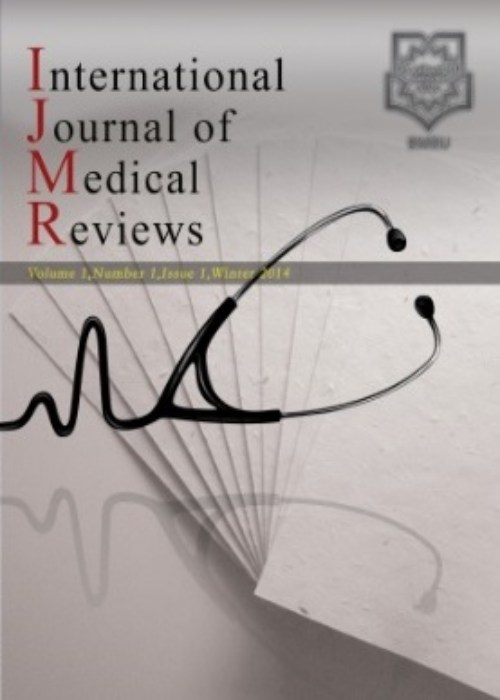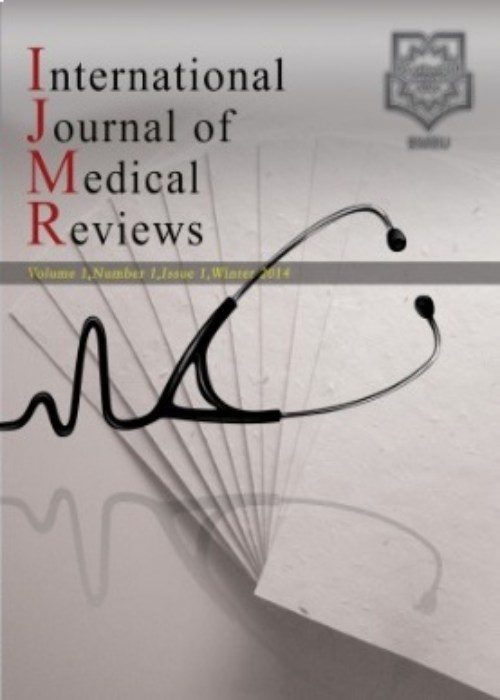فهرست مطالب

International Journal of Medical Reviews
Volume:10 Issue: 2, Spring 2023
- تاریخ انتشار: 1402/03/30
- تعداد عناوین: 6
-
-
Pages 485-496Introduction
Throughout the pandemic, radiographers globally continued to offer services, putting them on the frontlines of the fight against the COVID-19 pandemic. Understanding the experiences radiographers have during pandemics is necessary to create specific support mechanisms and to prepare for future pandemics or health crises. The aim of this review was to synthesize qualitative primary research on the experiences of radiographers during the COVID-19 pandemic.
MethodsA qualitative systematic review was conducted according to the Enhancing Transparency in Reporting the Synthesis of Qualitative Research (ENTREQ) guidelines.
ResultsSeven studies were found that addressed the experiences of radiographers using a qualitative methodology and were deemed of sufficient quality to be included in the review. Five key themes emerged, including factual information challenges,increased human emotional responses, altered workplace conditions, increased mental health concerns, and support for radiographers.
ConclusionRadiographers, like many other healthcare professionals, faced information, fear, anxiety, and heightened mental issues. Despite these challenges, some radiographers complained about a lack of adequate support. We hope that this review will enhance the understanding of the experiences of radiographers during pandemics so as to create specific support mechanisms and also prepare for future pandemics or health crises.
Keywords: Experiences, Radiographers, COVID-19, Systematic review -
Pages 497-506Introduction
Management of brainstem metastatic tumor is challenging. brainstem metastasis is an uncommon complication of systemic cancer, generally considered to have a highly unfavorable prognosis. Surgical risks are high and standard radiation or chemotherapy have little effect. The purpose of this study is to evaluate our experience an overview of the removal of abnormalities of brain stem metastases and the general treatment protocol of these types of metastases, which are very unfavorable.
MethodsThe present paper is a literature review using the following databases: PubMed, Scientific Direct, Library Genesis, using the terms: Brainstem Metastases Malformation. Articles from May 2019 were selected, resulting in a total of 19 articles that met the inclusion criteria considering their citations and respective impacts.
ResultsComplications were predicted and observed according to existing factors and factors that will arise in the future. Local tumor control was achieved in 90.7% of patients.
ConclusionThe results of this small series demonstrate that treatments now can be a valuable modality for safe and effective management of brain stem metastasis. Owing to the high risk of surgical resection and low efficacy of medical treatment, radiosurgery can be proposed upfront
Keywords: Brainstem Metastatic, radiosurgery, Systemic Cancer, Chemotherapy, Abnormalities -
Pages 507-515Introduction
Postgraduate education assists in meeting the specialisation of radiographers in different imaging modalities, thereby improving the quality of imaging services. Studies have been conducted on the motivating factors influencing radiographers to undertake postgraduate studies. However, there has been no published review to draw together the findings of such studies. This would provide evidence for future postgraduate course planning, delivery, and evaluation. The aim of this study was to systematically review the primary research studies on the motivating factors influencing radiographers to undertake postgraduate studies.
MethodsA qualitative systematic review was conducted guided by the Enhancing Transparency in Reporting the Synthesis of Qualitative Research (ENTREQ) guidelines. The literature search was conducted from April to September 2022 in two databases: PubMed/MEDLINE, and ScienceDirect, as well as other sources. Studies were assessed for quality, data was extracted and re-interpreted using framework analysis.
ResultsSeven studies were identified and included in this review. This review found that both intrinsic and extrinsic factors influenced radiographers to undertake postgraduate studies. Four motivating intrinsic factors were identified: personal desire for new knowledge and managerial positions, pre-requisite for the doctorate programme, and job and professional satisfaction. On the other hand, four motivating extrinsic factors were also identified: availability and flexibility of postgraduate courses, specialisation, continuous professional development, and promotion and remuneration.
ConclusionThe overall results of this review show that radiographers were motivated to pursue postgraduate studies. The findings will assist educators to understand the personal drivers for radiographers wanting to embark on post-graduate studies.
Keywords: Extrinsic Factors, Motivation, Postgraduate, Radiographer, Intrinsic Factors -
Pages 516-522Parkinson’s disease (PD) is a widespread degenerative illness impacting the human central, peripheral, and gastrointestinal nervous systems. The underlying pathological process progresses slowly but relentlessly and involves multiple neuronal systems. The disease is the consequence of changes in the neuronal cytoskeleton developing in only a few susceptible types of nerve cells. The cardinal features of PD are bradykinesia, rigidity, tremor, and postural instability. There are a number of neurologic conditions that mimic the disease, making it difficult to diagnose in its early stages. Physicians who rarely diagnose PD should refer patients suspected of having it to physicians with more experience in making the diagnosis, and should periodically reevaluate the accuracy of the diagnosis. Several studies have shown associations between PD risk and individual foods and nutrients with inconsistent results is now clear that genetic susceptibility and environmental factors play a role in disease etiology and progression. Because environmental factors are involved with the majority of the cases of PD, it is important to understand the role nutrition plays in both neuroprotection and neurodegeneration. Helicobacter pylori has been implicated in the pathogenesis of PD. Its eradication, in a randomized placebo-controlled trial, improved PD inactive Helicobacter species zoonosis might explain excess mortality from PD and non-Hodgkin lymphoma in livestock, but not arable, farmers. Indeed, Helicobacter is causally-associated with gastric lymphoma.Keywords: Parkinson disease, nutrition, Dietary Pattern, Helicobacter pylori, Interaction, Levodopa, Epidemiology
-
Pages 523-528IntroductionTo demonstrate that birth asphyxia is a risk factor of in vitro Fertilization in Cameroon.MethodsA retrospective cohort study was conducted at the pediatric department of the Hospital Center for Research and Application in Endoscopic Surgery and Human Reproduction (HCRAESHR) in Yaoundé. Every newborn, from in vitrofertilization (exposed group) and spontaneous conception (non-exposed group) after a single pregnancy was included and those from multiple pregnancies were excluded. Each group contained 100 newborns that were matched according to the mode of delivery. The data collection lasted 8 months. For that, the birth medical records of the newborns were used and data were reported on individual questionnaires. The absence of cry at birth, an Apgar score<7 at the 5th minute of life, and the concept of neonatal resuscitation including at least the mask ventilation, were the three criteria measured for considering a newborn as having birth asphyxia. A p-value≤0.05 signed the statistical significance of all our results.ResultsThe mean maternal age was 40.55 ± 8.35 years in exposed group against 35.72 ± 5.01 years in non-exposed group (p = 0.000). The birth asphyxia was significantly predominant in exposed group (35% and 11% respectively, p = 0.000), in comparison to non- exposed group. Exposed group had 3.85 times higher risk to have birth asphyxia compared to non-exposed group (p = 0.001) while controlling for confounding factors (maternal age, maternal hypertension, prematurity and the sex of the baby.ConclusionThis study clearly established that in vitro fertilization can cause birth asphyxia.Keywords: In vitro fertilization, Asphyxia, birth, risk, Cameroon
-
Pages 529-532
Usual neurological complications of Epstein-Barr virus infection are aseptic meningitis, encephalitis, transverse Usual neurological complications of Epstein-Barr virus infection are aseptic meningitis, encephalitis, transverse myelitis, cerebellitis, Guillain-Barre syndrome, and cranial or peripheral neuritis most commonly in immunocompromised patients. These clinical manifestations may occur alone or accompanied by infectious mononucleosis. Usually, EBV encephalitis occurs infrequently and with non-specific symptoms. Herein, we report two patients: a 24-year-old female with generalized tonic-clonic fever and seizures for ten days. The other was a 28-year-old male with repeated fever, headache, 4-day amnesia, and symptoms of meningeal irritation. Since the physical examination results were not very helpful, the definite diagnosis was achieved by sampling, analysis, and polymerase chain reaction for the cerebrospinal fluid. Our patients had a direct EBV invasion of the CNS and were affected by Epstein-Barr virus encephalitis, confirmed by their clinical test results as a positive polymerase chain reaction of cerebrospinal fluid. The PCR results were negative for a panel of microorganisms that cause bacterial meningitis in the CSF, but positive for EBV. Image findings also did not show any significant results. Patients treated with acyclovir and precision control at the relative center with favorable outcomes. Acyclovir possibly will lessen viral replication. Finally, despite obtaining negative test results of EBV infection, every therapeutic effort should be undertaken and maintained continuous attention.
Keywords: Meningoencephalitis, Meningitis, Epstein-Barr Virus, Meningeal Irritation, Infection, Antiviral agents


